Class Amphibia marks the vertebrate transition from aquatic environment onto land.
- Amphibia means “both life.” Most amphibians spend parts of their life in aquatic environments and part in the terrestrial. Due to their life cycle and physiology, many amphibians are “tied” to water in order to survive and reproduce. (Shell-less eggs, thin, moist skin, and gilled larvae prevent most from ever being fully terrestrial)
- Evolved from lobe-finned fishes (Sarcopterygii) ~370 million years ago
- Moist, thin skin
- Sense organs for detecting sounds and scents (life on land)
- Amphibian means “both life”
Major Evolutionary Advancement – Four limbs
- Four strong limbs developed from fins.
- Well-developed shoulders and hipbones to support weight (life on land).
- Class Amphibia marks the start of superclass tetrapoda (four-limbed vertebrates)
- Class Amphibia, Reptilia, Aves, and Mammalia are all tetrapods.
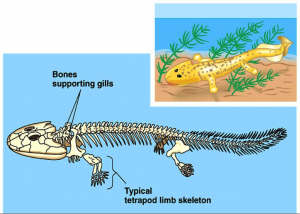
Figure 1: Tiktaalik – a transitional fossil between fish and amphibians
Fun fact: Tiktaalik – A transition fossil between lobe-finned fish and amphibians. (Found on Ellesmere island, Canada). Tiktaalik is considered one of the most important transition fossils in the vertebrate transition to terrestrial environments.
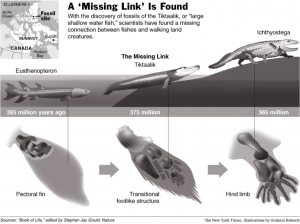
More on transitional fossils – Video from class [hhmi]
Major Evolutionary Advancement – Pulmonary Circuit
- Three chambered heart with double circulation
- Double circulation – Amphibians are the first vertebrates to evolve a double circulation system. The evolution of the second circulatory loop allows for more oxygen to be delivered around their body at greater speeds when compared to fish.
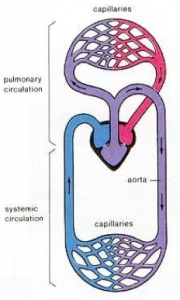
Figure 3: Typical amphibian circulatory system - The pulmonary circulatory loop connects the heart to the lungs and skin where gas exchange occurs. This creates oxygen-rich blood which is then pumped out around the body. The vessels which connect the heart to the lungs are called pulmonary veins.
- Pulmonary circuit (to lungs/skin for gas exchange)
- Systemic circuit (around body to tissues)
- Since amphibians only have one ventricle – the deoxygenated and oxygenated blood mixes before being pumped around the body.
Question: Is the mixing of deoxygenated and oxygenated blood before it circulates to body tissues efficient? Why or why not? Is there any evolutionary prediction you can make in terms of the circulatory system?
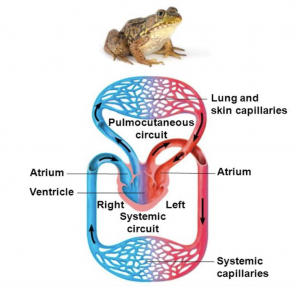
General anatomy:
- Limbs with no claws and typically webbed feet.
- Short neck with flat head (similar to many transition fossils)
Integument – Thin, moist skin
Amphibians have an integumentary system similar to a worms. Their skin is extremely thin and moist. It is water permeable, which means water can pass through their skin (They “drink” through their skin).
They also produce a mucus with the help of mucus glands. The mucus serves to keep the skin moist and aids in gas exchange (amphibians can “skin breathe” – see more under respiration) . A layer of mucus on the skin helps keep moisture trapped next to it, and this moisture transfers oxygen into the frog’s body. In this way the mucus on a frog’s skin is extremely important to its well-being.
Some also have poison glands that are used as protection from predators. These glands produce a wide variety of compounds that are toxic to potential predators (as well as humans!) Poisonous amphibians are often bright and colourful to warn potential predators. Due to this, we think of frogs as poisonous since the toxin is passed passively.
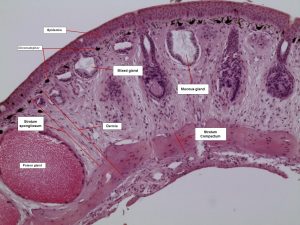
What is interesting as well is that many of these poisonous amphibians actually get their poison from toxic prey they typically feed on in the wild.
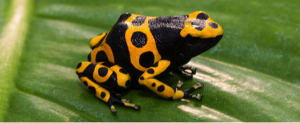
No toxic prey = inability to produce poisonous alkaloids in significant levels. Therefore, some typically poisonous amphibians are not actually poisonous when raised in captivity.
This means a frogs toxicity is based on their diet – this is called the diet-toxicity hypothesis.
Physiology
Metamorphosis
- Metamorphosis = process of transformation with 2 or more distinct stages (immature->adult)
- Metamorphosis is stimulated by a hormone called thyroxine.
- Tadpole (A) (fish-like larvae) hatch from eggs adapted to aquatic life. (Nutrients from yolk sac)
- Tadpole (B): Tadpoles grow larger and develop three pairs of gills. No more yolk sac – nutrients from filter feeding (herbivore)

Figure 7: Amphibian life cycle. Note that tadpoles are aquatic where as adults are terrestrial - Developed Tadpole: (C) Hind limbs begin to develop.
- Froglet: (D): Fore limbs develop and lungs replace gills. Amphibian crawls onto land, jaws and teeth develop.
- Adult (E): Tail continues to disappear until adulthood. Carnivorous/respires with lungs
Digestive system
- Amphibians have the first true tongues in vertebrates. Order Anura – frogs and toads – have long sticky tongues that are folded backwards in their mouths and are carnivorous.
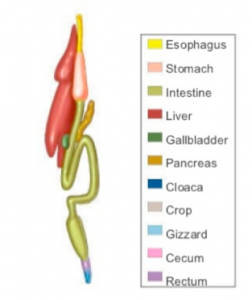
Figure 7: Digestive system - The walls of the pharynx (throat) are complete (no gill slits in adult form).
- The intestine is long and coiled tube (much longer than in fish). And the level of differentiation and sectioning is becoming much more pronounced (i.e. stomach is more than just a “bend”)
- Cloaca is present
Reproduction
- Oviparous
- Lay eggs in fresh water (or moist environments, such as on leaves in jungles – Glass Frog)
- External fertilization after amplexus (typically)
- Amplexus = mating position of amphibians. Male climbs onto females back (sometimes several days!)
- Eggs are coated with a jelly-like substance when they are expelled from the female cloaca
- Parental care is common (increases survival rate)
- Most often the male remains with eggs to guard them
-

Figure 8: Frogs in amplexus https://www.youtube.com/watch?v=IAF5N-HwgOc&t=9s
Question: If parental care can increase survival rate of offspring, why isn’t it observed in all species?
Respiration:
- Tadpoles have gills
- Adults respire with lungs and cutaneous respiration (Skin breathing)
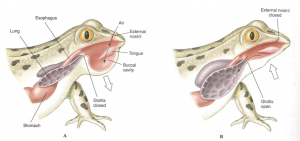
Figure 9: Amphibian lungs - Oxygen can pass through the skin, and enter directly into the blood.
- Adult frogs have paired, simple, sac-like lungs.
- Almost all frogs develop lungs when they develop into adults, but they still depend on cutaneous gas exchange to get oxygen, especially when the frog is in a burrow underground or swimming in the water.
Groups of Amphibians
Note: For tests/quizzes you do not need to know the orders.

Order Anura (Frogs and toads):
- Toad = anuran with rough bumpy skin. (more time on land)
- Frog is = anuran with smooth moist skin. (more time in water)
- 90% of all living amphibians
- Males produce many vocalizations to attract females and warn off other males. Each species has its own mating call.
- Body adapted for jumping
- All carnivorous (some with sticky tongue to catch prey)
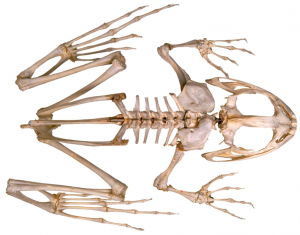
Order Urodela (Salamanders and newts):
- Four-limbs, elongated bodies
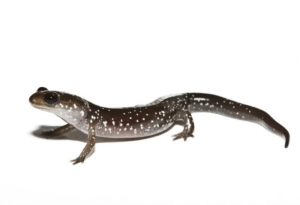
Figure 12: Salamander (Order Urodela) - Many are completely lung less and rely on respiration through skin exclusively.
- Many are slow, thin skinned, and soft (seemingly easy prey). However, they can regenerate limbs, tails, and complex tissues such as eyes.
Fun fact: Salamander brandy is a (legendary) drink made with fermented fruit and one salamander added. The salamander adds its toxins to the alcohol producing a hallucinogenic and aphrodisiac effect. However, many claim this is not the case and rather individuals may experience paralysis in the legs – one of the effects of samandarine poisoning!
Order Apoda (Caecilians):
- Limbless amphibians that are often blind (resemble snakes).

Figure 13: Caecilian (Order Apoda) - Detect prey with chemosensory tentacles on the side of their head.
- Exclusively internal fertilization with viviparousity (only amphibians with this reproductive method)
- Many live underground.
Amphibian Spotlight
- Family Dendrobatidae (Poison dart frogs)
- Poison dart frogs are bright coloured frogs (warning potential predators of their toxicity) named from the indigenous peoples use of their poison to tip their darts when hunting.
- The poison of the golden poison frog (Phyllobates terribilis) is so strong one milligram is enough to kill about 10,000 mice. Or enough to kill between 10 and 20 humans (1 gram = 15,000 humans).

Figure 14: Poison dart frog species - However, captive-bred frogs are not poisonous.
- Poison dart frogs actually get their poison from toxic arthropod prey they typically feed on in the wild. No toxic prey = inability to produce poisonous alkaloids in significant levels.
- One snake – Fire-Bellied snake (Leimadophis epinephelus) – has evolved immunity to the poison and actively preys on them.
Extra Questions:
- Compare members of Class Osteichthyes with Class Amphibia.
- What is the diet-toxicity hypothesis?
- What is the difference between a poisonous animal and a venomous animal?
- Compare and contrast the three major groups of amphibians.
- Are amphibians fully terrestrial? Justify your answer with examples.
- Describe the process of cutaneous respiration.
- What can transition fossils like Tiktaalik tell us about the evolution of vertebrates
- Outline the stages of amphibian metamorphosis. Be sure to include at least 4 stages (The life cycle you made in class will provide you with more information).
- Describe the skin of a typical amphibian.
- Are their any potential negatives of having thin, moist skin as a terrestrial animal? What adaptations do amphibians have to combat these negatives?
Comments by shaun pletsch